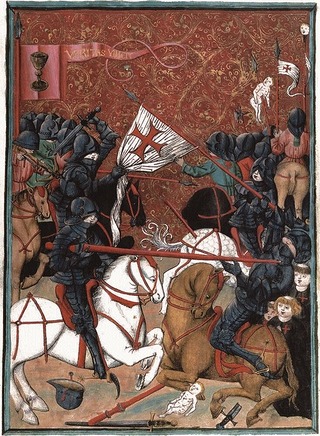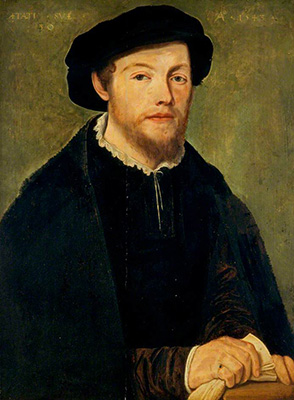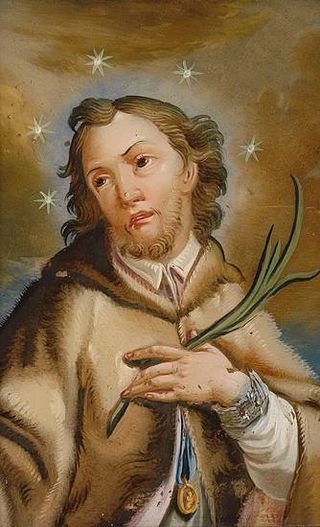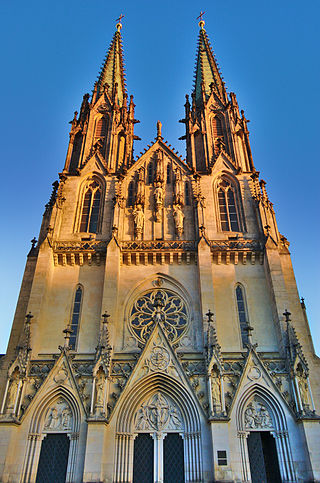
The Hussites were a Czech proto-Protestant Christian movement that followed the teachings of reformer Jan Hus, who became the best known representative of the Bohemian Reformation.

Jan Hus, sometimes anglicized as John Hus or John Huss, and referred to in historical texts as Iohannes Hus or Johannes Huss, was a Czech theologian and philosopher who became a Church reformer and the inspiration of Hussitism, a key predecessor to Protestantism, and a seminal figure in the Bohemian Reformation. Hus is considered by some to be the first Church reformer, even though some designate the theorist John Wycliffe. His teachings had a strong influence, most immediately in the approval of a reformed Bohemian religious denomination and, over a century later, on Martin Luther. Hus was a master, dean and rector at the Charles University in Prague between 1409 and 1410.

The Defenestrations of Prague were three incidents in the history of Bohemia in which people were defenestrated. Though already existing in Middle French, the word defenestrate is believed to have first been used in English in reference to the episodes in Prague in 1618 when the disgruntled Protestant estates threw two royal governors and their secretary out of a window of the Hradčany Castle and wrote an extensive apologia explaining their action. In the Middle Ages and early modern times, defenestration was not uncommon—the act carried elements of lynching and mob violence in the form of murder committed together.

The Hussite Wars, also called the Bohemian Wars or the Hussite Revolution, were a series of civil wars fought between the Hussites and the combined Catholic forces of Holy Roman Emperor Sigismund, the Papacy, European monarchs loyal to the Catholic Church, as well as various Hussite factions. At a late stage of the conflict, the Utraquists changed sides in 1432 to fight alongside Roman Catholics and opposed the Taborites and other Hussite spinoffs. These wars lasted from 1419 to approximately 1434.

George Wishart was a Scottish Protestant Reformer and one of the early Protestant martyrs burned at the stake as a heretic.

Henry Wardlaw was a Scottish church leader, Bishop of St Andrews and founder of the University of St Andrews.

Patrick Hamilton was a Scottish churchman and an early Protestant Reformer in Scotland. He travelled to Europe, where he met several of the leading reformed thinkers, before returning to Scotland to preach. He was tried as a heretic by Archbishop James Beaton, found guilty and handed over to secular authorities to be burnt at the stake in St Andrews as Scotland's first martyr of the Reformation.

John of Nepomuk was the saint of Bohemia who was drowned in the Vltava river at the behest of Wenceslaus IV of Bohemia. Later accounts state that he was the confessor of the queen of Bohemia and refused to divulge the secrets of the confessional. On the basis of this account, John of Nepomuk is considered the first martyr of the Seal of the Confessional, a patron against calumnies and, because of the manner of his death, a protector from floods and drowning.

Prokop the Great or Prokop the Bald or the Shaven was a Czech Hussite general and a prominent Taborite military leader during the Hussite Wars. On his mother's side, he came from a German patrician family living in Prague.

František Palacký was a Czech historian and politician, the most influential person of the Czech National Revival, called "Father of the Nation".

Jerome of Prague was a Czech scholastic philosopher, theologian, reformer, and professor. Jerome was one of the chief followers of Jan Hus and was burned for heresy at the Council of Constance.

The Kingdom of Bohemia, sometimes referenced in English literature as the Czech Kingdom, was a medieval and early modern monarchy in Central Europe. It was the predecessor of the modern Czech Republic.
Protestantism originated from the Protestant Reformation of the 16th century. The term Protestant comes from the Protestation at Speyer in 1529, where the nobility protested against enforcement of the Edict of Worms which subjected advocates of Lutheranism to forfeit of all their property. However, the theological underpinnings go back much further, as Protestant theologians of the time cited both Church Fathers and the Apostles to justify their choices and formulations. The earliest origin of Protestantism is controversial; with some Protestants today claiming origin back to people in the early church deemed heretical such as Jovinian and Vigilantius.
Craw is an English habitational name that arrived in Britain with Anglo-Saxon tribes. Residents of the village Cronkshaw in the county of Lancashire adopted Craw as their surname.

Walter Milne, also recorded as Mill or Myln, was the last Protestant martyr to be burned in Scotland before the Scottish Reformation changed the country from Catholic to Presbyterian.

Religion in the Czech Republic is varied, with 47.8% being irreligious and 30.1% who did not respond when asked about their beliefs. The numbers of irreligious and non-responding people might be attributable to 40 years spent under communist rule, during which atheism was institutionalised. The religious identity of the country has changed drastically since the first half of the 20th century, when more than 90% of Czechs were Christians. As of 2021, 11.7% of the population identified with Christianity whilst 10.8% identified with other religious identities or beliefs. According to sociologist Jan Spousta, not all the irreligious people are atheists; indeed, since the late 20th century there has been an increasing distancing from both Christian dogmatism and atheism, and at the same time ideas and non-institutional models similar to those of Eastern religions have become widespread through movements started by various gurus, and hermetic and mystical paths.

Přemek I, Duke of Opava' was a member of the Opava branch of the Bohemian Přemyslid dynasty. He was Duke of Opava from 1367 until his death and Głubczyce from 1394 until his death.

Duke Wenceslaus II of Opava was a member of the Opavian branch of the Přemyslid dynasty. He was Duke of Opava from 1433 until his death. From 1435 until his death, he was also Duke of Głubczyce and Lord of Fulnek.

The Bohemian Reformation, preceding the Reformation of the 16th century, was a Christian movement in the late medieval and early modern Kingdom and Crown of Bohemia striving for a reform of the Catholic Church. Lasting for more than 200 years, it had a significant impact on the historical development of Central Europe and is considered one of the most important religious, social, intellectual and political movements of the early modern period. The Bohemian Reformation produced the first national church separate from Roman authority in the history of Western Christianity, the first apocalyptic religious movement of the early modern period, and the first pacifist Protestant church.

Mikuláš of Pelhřimov, also called Mikuláš Biskupec was a Czech Hussite priest, bachelor of liberal arts, from 1420 the head ("bishop") of the independent Taborite church. In the theological polemics against the Prague masters he was the main spokesman for the Taborites and their most important theologist. His treatise Confessio Taboritarum was significant in the international Reformation literature and is known from 16th and early 17th century prints.
















